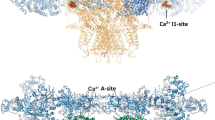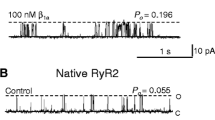Abstract
Much recent progress has been made in our understanding of the mechanism of sarcoplasmic reticulum Ca2+ release in skeletal muscle. Vertebrate skeletal muscle excitation-contraction (E-C) coupling is thought to occur by a “mechanical coupling” mechanism involving protein-protein interactions that lead to activation of the sarcoplasmic reticulum (SR) ryanodine receptor (RyR)/Ca2+ release channel by the voltage-sensing transverse (T−) tubule dihydropyridine receptor (DHPR)/Ca2+ channel. In a subsequent step, the released Ca2+ amplify SR Ca2+ release by activating release channels that are not linked to the DHPR. Experiments with mutant muscle cells have indicated that skeletal muscle specific DHPR and RyR isoforms are required for skeletal muscle E-C coupling. A direct functional and structural interaction between a DHPR-derived peptide and the RyR has been described. The interaction between the DHPR and RyR may be stabilized by other proteins such as triadin (a SR junctional protein) and modulated by phosphorylation of the DHPR.
Similar content being viewed by others
References
Airey, J. A., Beck, C. F., Murakami, K., Tanksley, S. J., Deerinck, T. J., Ellisman, M. H. and Sutko, J. L. (1990) Identification and localization of two triad junctional foot protein isoforms in mature avian fast twitch skeletal muscle.J. Biol. Chem.,265:14187–14194.
Anderson, K., Cohn, A. H. and Meissner, G. (1994) High-affinity [3H]PN200-110 and [3H]ryanodine binding to rabbit and frog skeletal muscle.Am. J. Physiol,266:C462-C466.
Anderson, K. and Meissner, G. (1995) T-tubule depolarization-induced SR Ca2+ release is controlled by dihydropyridine receptor- and Ca2+-dependent mechanisms in cell homogenates from rabbit skeletal muscle.J. Gen Physiol,105:363–383.
Beam, K. G., Knudson, C. M. and Powell, J. A. (1986) A lethal mutation in mice eliminates the slow calcium current in skeletal muscle cells.Nature,320:168–170.
Block, B. A., Imagawa, T., Campbell, K. P. and Franzini Armstrong, C. (1988) Structural evidence for direct interaction between the molecular components of the transverse tubule/sarcoplasmic reticulum junction in skeletal muscle.J. Cell Biol.,107:2587–2600.
Brandt, N. R., Casewell, A. H., Brunschwig, J. P., Kang, J. J., Antoniu, B. and Ikemoto, N. (1992) Effects of anti-triadin antibody on Ca2+ release from sarcoplasmic reticulum.FEBS Lett.,299:57–59.
Brandt, N. R., Caswell, A. H., Carl, S. A., Ferguson, D. G., Brandt, T., Brunschwig, J. P. and Bassett, A. L. (1993) Detection and localization of triadin in rat ventricular muscle.J. Membr. Biol.,131:219–228.
Caswell, A. H., and Corbett, A. M. (1985) Interaction of glyceraldehyde-3-phosphate dehydrogenase with isolated microsomal subfractions of skeletal muscle.J. Biol. Chem.,260:6892–6898.
Caswell, A. H., Brandt, N. R., Brunschwig, J. P. and Purkerson, S. (1991) Localization and partial characterization of the oligomeric disulfide-linked molecular weight 95,000 protein (triadin) which binds the ryanodine and dihydropyridine receptors in skeletal muscle triadic vesicles.Biochemistry,30:7507–7513.
Catterall, W. A. (1995) Structure and function of voltage-gated ion channels.Annu. Rev. Biochem.,64:493–531.
Chang, C. F., Gutierrez, L. M., Mundina Weilenmann, C. and Hosey, M. M. (1991) Dihydropyridine-sensitive calcium channels from skeletal muscle. II. Functional effects of differential phosphorylation of channel subunits.J. Biol. Chem.,266:16395–16400.
DeFelice, L. J. (1993) Molecular and biophysical view of the Ca channel: a hypothesis regarding oligomeric structure, channel clustering, and macroscopic current.J. Membr. Biol.,133:191–202.
DeJongh, K. S., Warner, C., Colvin, A. A. and Catterall, W. A. (1991) Characterization of the two size forms of the α1 subunit of skeletal muscle L-type calcium channels.Proc. Nad. Acad. Sci. USA,88:10778–10782.
DeWaard, M., Witcher, D. R., Pragnell, M., Liu, H., and Campbell, K. P. (1995) Properties of the α1-β anchoring site in voltage-dependent Ca2+ channels.J. Biol. Chem.,270:12056–12064.
Fan, H., Brandt, N. R. and Caswell, A. H., (1995) Disulfide bonds, glycosilation sites and membrane topology of skeletal muscle triadin.Biophys. J.,68:A416.
Franzini-Armstrong, C. and Jorgensen, A. O. (1994) Structure and development of E-C coupling units in skeletal muscle.Annu. Rev. Physiol,56:509–534.
Gregg, R. G., Messing, A., Moss, R., Behan, M., Coronado, R., Strube, C. and Powers, P. A. (1995) The beta subunit of the L-type VDCC (CACNLB1) is essential for excitation-contraction coupling.Biophys. J.,68:A372.
Grunwald, R. and Meissner, G. (1995) Lumenal sites and C terminus accessibility of the skeletal muscle calcium release channel (ryanodine receptor).J. Biol. Chem.,270:11338–11347.
Guo, W. and Campbell, K. P. (1995) Association of triadin with the ryanodine receptor and calsequestrin in the lumen of the sarcoplasmic reticulum.J. Biol. Chem.,270:9027–9030.
Hakamata, Y., Nakai, J., Takeshima, H. and Imoto, K. (1992) Primary structure and distribution of a novel ryanodine receptor/calcium release channel from rabbit brain.FEBS lett.,312:229–235.
Ivanenko, A., McKemy, D. D., Kenyon, J. L., Airey, J. A. and Sutko, J. L. (1995) Embryonic chicken skeletal muscle cells fail to develop normal excitation-contraction coupling in the absence of the α ryanodine receptor. Implications for a two-ryanodine receptor system.J. Biol. Chem.,270:4220–4223.
Kim, K. C., Caswell, A. H., Talvenheimo, J. A. and Brandt, N. R. (1990) Isolation of a terminal cisterna protein which may link the dihydropyridine receptor to the junctional foot protein in skeletal muscle.Biochemistry,29:9281–9289.
Knudson, C. M., Stang, K. K., Moomaw, C. R., Slaughter, C. A. and Campbell, K. P. (1993) Primary structure and topological analysis of a skeletal muscle-specific junctional sarcoplasmic reticulum glycoprotein (triadin).J. Biol. Chem.,268:12646–12654.
Lai, Y., Seagar, M. J., Takahashi, M. and Catterall, W. A. (1990) Cyclic AMP-dependent phosphorylation of two size forms of al subunits of L-type calcium channels in rat skeletal muscle cells.J. Biol. Chem.,265:20839–20848.
Lai, F. A., Liu, Q. Y., Xu, L., El-Hashem, A., Kramarcy, N. R., Sealock, R. and Meissner, G. (1992) Amphibian ryanodine receptor isoforms are related to those of mammalian skeletal or cardiac muscle.Am. J. Physiol.,263:C365-C372.
Ledbetter, M. W., Freiner, J. K., Louis, C. F. and Mickelson, J. R. (1994) Tissue distribution of ryanodine receptor isoforms and alleles determined by reverse transcription polymerase chain reaction.J. Biol. Chem.,269:31544–31551.
Lewis Carl, S., Felix, K., Caswell, A. H., Brandt, N. R., Ball, W. J., Vaghy, P. L., Meissner, G. and Ferguson, D. G. (1995a) Immunolocalization of sarcolemmal dihydropyridine receptor and sarcoplasmic reticular triadin and ryanodine receptor in rabbit ventricle and atrium.J. Cell. Biol.,129:673–682.
Lewis Carl, S., Felix, K., Caswell, A. H., Brandt, N. R., Brunschwig, J.-P., Meissner, G. and Ferguson, D. G. (1995b) Immunolocalization of triadin, DHP receptors, and ryanodine receptors in adult and developing skeletal muscle of rats.Muscle & Nerve,18: (in press).
Liu, G. and Pessah, I. N. (1994) Molecular interaction between ryanodine receptor and glycoprotein triadin involves redox cycling of functionally important hyperreactive sulfhydrils.J. Biol. Chem.,269:33028–33034.
Lu, X., Xu, L. and Meissner, G. (1994) Activation of the skeletal muscle calcium release channel by a cytoplasmic loop of the dihydropyridine receptor.J. Biol. Chem.,269:6511–6516.
Lu, X., Xu, L. and Meissner, G. (1995) Phosphorylation of dihydropyridine receptor II-III loop peptide regulates skeletal muscle calcium release channel function. Evidence for an essential role of the β-OH group of Ser687.J. Biol. Chem.,270:18559–18464.
Marty, I., Villaz, M., Arlaud, G., Bally, I. and Ronjat, M. (1994a) Transmembrane orientation of the N-terminal and C-terminal ends of the ryanodine receptor in the sarcoplasmic reticulum of rabbit skeletal muscle.Biochem. J.,15:743–749.
Marty, I., Robert, M., Villaz, M., Da Jongh, K., Lai, Y., Catterall, W. A. and Ronjat, M. (1994b) Biochemical evidence for a complex involving dihydropyridine receptor and ryanodine receptor in triad junctions of skeletal muscle.Proc. Natl. Acad. Sci. USA,91:2270–2274.
Meissner, G. (1994) Ryanodine receptor/Ca2+ release channels and their regulation by endogeneous effectors.Annu. Rev. Physiol,56:485–508.
Mundina-Weilenmann, C., Ma, J., Rios, E. and Hosey, M. M. (1991) Dihydropyridine-sensitive skeletal muscle calcium channels in polarized planar bilayers. 2. Effects of phosphorylation by cAMP-dependent protein kinase.Biophys. J.,60:902–909.
Nunoki, K., Florio, V. and Catterall, W. A. (1989) Activation of purified calcium channels by stoichiometric protein phosphorylation.Proc. Natl. Acad. Sci. USA,86:6816–6820.
Ogawa, Y. (1994) Role of ryanodine receptors.Crit Rev. Biochem. Mol. Biol.,29:229–274.
Oyamada, H., Murayama, T., Takagi, T., Iino, M., Iwabe, N., Miyata, T., Ogawa, Y. and Endo, M. (1994) Primary structure and distribution of ryanodine-binding protein isoforms of the bullfrog skeletal muscle.J. Biol. Chem.,269:17206–17214.
Radermacher, M., Rao, V., Grassucci, R., Frank, J., Timerman, A. P., Fleischer, S. and Wagenknecht, T. (1994) Cryo-electron microscopy and three-dimensional reconstruction of the calcium release channel/ryanodine receptor from skeletal muscle.J. Cell. Biol.,127:411–423.
Rios, E. and Pizarro, G. (1991) Voltage sensor of excitation-contraction coupling in skeletal muscle.Physiol Rev.,71:849–908.
Rohrkasten, A., Meyer, H. E., Nastainczyk, W., Sieber, M. and Hofmann, F. (1988) cAMP-dependent protein kinase rapidly phosphorylates serine-687 of the skeletal muscle receptor for calcium channel blockers.J. Biol. Chem.,263:15325–15329.
Rotman, E. I., Murphy, B. J. and Catterall, W. A. (1995) Sites of selective cAMP-dependent phosphorylation of the L-type calcium channel α1 subunit from intact rabbit skeletal muscle myotubes.J. Biol. Chem.,270:16371–16377.
Schneider, M. F. (1994) Control of calcium release in functioning skeletal muscle fibers.Annu. Rev. Physiol.,56:463–484.
Serysheva, I. I., Orlova, E. V., Chiu, W., Sherman, M. B., Hamilton, S. L. and van Heel, M. (1995a) Electron cryomicroscopy and angular reconstitution used to visualize the skeletal muscle calcium release channel.Nat. Struct. Biol.,2:18–24.
Serysheva, I. I., Orlova, E. V., Sherman, M. B., Heel, M. V., Chiu, W. and Hamilton, S. L. (1995b) 3D structure of the skeletal muscle Ca2+ release channel in its open and closed states by electron cryomicroscopy and angular reconstruction.Biophys. J.,68:A128.
Sun, X. H., Protasi, F., Takahashi, M., Takeshima, H., Ferguson, D. G. and Franzini Armstrong, C., (1995) Molecular architecture of membranes involved in excitation-contraction coupling of cardiac muscle.J. Cell. Biol.,129:659–671.
Takekura, H., Nishi, M., Noda, T., Takeshima, H. and Franzini Armstrong, C. (1995) Abnormal junctions between surface membrane and sarcoplasmic reticulum in skeletal muscle with a mutation targeted to the ryanodine receptor.Proc. Natl. Acad. Sci. USA,92:3381–3385.
Takeshima, H., Yamazawa, T., Ikemoto, T., Takekura, H., Nishi, M., Noda, T. and Iino, M. (1995) Ca2+-induced Ca2+ release in myocytes from dyspedic mice lacking the type-1 ryanodine receptor.EMBO J.,14:2999–3006.
Tanabe, T., Beam, K. G., Powell, J. A. and Numa, S. (1988) Restoration of excitation-contraction coupling and slow calcium current in dysgenic muscle by dihydropyridine receptor complementary DNA.Nature,336:134–139.
Tanabe, T., Mikami, A., Numa, S. and Beam, K. G. (1990a) Cardiac-type excitation-contraction coupling in dysgenic skeletal muscle injected with cardiac dihydropyridine receptor cDNA.Nature,344:451–453.
Tanabe, T., Beam, K. G., Adams, B. A., Niidome, T. and Numa, S. (1990b) Regions of the skeletal muscle dihydropyridine receptor critical for excitation-contraction coupling.Nature,346:567–569.
Thieleczek, R., Mayr, G. W. and Brandt, N. R. (1989) Inositol polyphosphate-mediated repartitioning of aldolase in skeletal muscle triads and myofibrils.J. Biol. Chem.,264:7349–7356.
Wier, W. G. (1990) Cytoplasmic [Ca2+] in mammalian ventricle: dynamic control by cellular processes.Annu. Rev. Physiol,52:467–485.
Author information
Authors and Affiliations
Rights and permissions
About this article
Cite this article
Meissner, G., Lu, X. Dihydropyridine receptor-ryanodine receptor interactions in skeletal muscle excitation-contraction coupling. Biosci Rep 15, 399–408 (1995). https://doi.org/10.1007/BF01788371
Received:
Issue Date:
DOI: https://doi.org/10.1007/BF01788371




